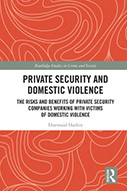Private Security And Domestic Violence: The Risks And Benefits Of Private Security

Author: Diarmid Harkin
Publisher: Abingdon, Oxon; New York, NY: Routledge, 2020. 164p.
Reviewer: Sandra Walklate | May 2021
Domestic violence (to use Harkin’s preferred term), and devising appropriate and effective policy responses to this issue, has proved to be challenging in a wide range of jurisdictions across the globe since the early 1980s. Led largely by North American interventions devised for implementation in a very particular jurisdiction in the northern hemisphere, academics, policymakers, and practitioners in the southern hemisphere have looked to, and been influenced by these developments in seeking out meaningful ways of responding to this issue. This northern influence, which Goodmark (2015) has referred to as ‘exporting without a license’ has not travelled the globe unscathed. Indeed, the efficacy of the turn to the criminal law as the primary response to domestic violence has been critiqued in terms of what it can achieve for women (see inter alia Mills 1999) and is currently undergoing significant challenge and reassessment (Goodmark 2018). Against this backcloth, the State of Victoria in Australia (where a good proportion of the work on which this book is based was conducted), stands as a shining light to the rest of the world in its commitment and political willingness to embrace a whole systems policy response to domestic violence, rather than primarily a legal one. Victoria appointed a Royal Commission on Family Violence which reported in 2016, and which made 227 recommendations for policy and practice. Its overriding aim was to bring such violence to an end, while keeping the perpetrator in view. The Victorian State Government committed to implementing all 227 recommendations and 5 years on that work is ongoing. I make these comments since it is important to understand this contribution by Harkin within this local context, and the extent to which this context has afforded a more open landscape in which effective responses to domestic violence might emerge.
Harkin offers a detailed analysis on why the work on which this book is based has emerged now. He points to the ongoing failures of state led criminal justice responses, the increasing presence of technology-based abuses as a feature of domestic violence, the growth of the private security sector more generally, and the increased availability of funding for domestic violence being made available in Australia in recent years. For example, in 2015 Prime Minister Malcolm Turnbull offered AS$100 million of federal funding to combat family violence. These factors provided both the opportunity and the space for a wide range of interested parties to enter the field of domestic violence, including those of the private security sector. Harkin is careful to point out that the involvement of the private security sector in relation to domestic violence is not only found in Australia, though in going on to document the empirical work on which this book is based, his data are clearly situated within that context, and primarily emanate from the states of Victoria, New South Wales and Queensland. Having explained the context in which space has been given for private security firms to work with victims of domestic violence, the main body of this book explores three themes through which to make sense of the empirical findings presented. These are roughly divided into focusing attention on the consequences which may ensue should security firms be found to be incompetent and/or unethical in their responses; the various advantages and disadvantages of the security focus on technical solutions to the problems posed for domestic violence victims; and, the benefits of private security interventions for victims and domestic violence service providers. Each of these themes is explored in meticulous detail and always cross-referenced with appropriate quotes from the data generated by the research. This review offers just a summary of some of the issues addressed.
In relation to the first two of these themes, some of the issues arising are perhaps unsurprising to those working in this field. For example, some perpetrators of domestic violence actually work within the private security sector, so questions arise as to the appropriateness of service delivery (by mostly men) to the vulnerable victims (mostly women). This issue seems, however, to have been discussed by the respondents quoted mostly in terms of competency as opposed to gender relations. In a similar vein, questions also emerged in relation to data protection (let alone data sharing) and related questions about accessing data (from CCTV coverage for example) for use in cases taken to court. In one case, a security company wanted extra payment for access to these data. The use and deployment of CCTV is an interesting one given the propensity of security companies to offer this as one of their technological fixes. Here (as is the case for special apps for mobile phones), the devices must be functional, user-friendly, and staffed appropriately to provide the level of response promised. Overall, the victims who had been offered and availed themselves of these services were afforded some peace of mind by having access to them, and a sense that at least someone had done something to help them. It is the potential for this kind of service delivery to be victim-oriented, the third theme that is generated in the findings presented here, that is worthy of slightly more detailed consideration.
Harkin makes the case, based on his evidence, that the presence of the private security sector in delivering services to victims of domestic abuse can provide both a victim-oriented and a victim-controlled service. Seen through the lens of customer satisfaction, this view is given some weight by victim testimony suggesting that it felt good that their safety mattered, that their safety was being informed by ‘experts’ (many of those working in this aspect of private security were ex-police officers who knew the risks and dilemmas being faced by victims), that they were being given a personal service, and through upgrading the security aspects of their homes they had greater confidence to stay in them. These are without doubt powerful observations, leading Harkin to suggest that private security firms may well constitute a worthwhile addition to the nodal governance of domestic violence. He goes on, however, to raise concerns surrounding how this node might be best regulated.
At this juncture it is important to clarify that Harkin’s work not only focused on victims as customers in receipt of private security, but also on the service providers whose responsibility it is to commission the services of the private security sector. This commissioning relationship itself, of course, could and did act as an important gatekeeper for security services which fell below par in terms of service delivery. This relationship in and of itself was rather hit and miss, raising the bigger question of regulation for these services. As Harkin points out, there are several different ways in which the question of regulation might be addressed: from letting the market decide, to a total ban, to introducing stronger state regulatory frameworks for such service delivery. Harkin opts for a model of civil regulation. Such regulatory body would include representatives from the domestic violence sector, local police and judiciary, local/national government, academics, and the private security sector. This body would follow the principles of responsive regulation (emanating from the widely recognized work of John Braithwaite) and would focus its work on the development of good practice and quality control. The overriding aim would be the concern to minimize the risks to victims that may ensue from the involvement of primarily profit-making organizations in responding to victims’ security needs.
The author is very aware of the wider skepticism that the involvement of private security in this field might provoke. Indeed, he is careful to point out that such developments are not in themselves simple solutions. At the same time, it would be foolish to disregard the increasing evidence surrounding the use of technology as a method of abuse and harm in abusive relationships. This increasingly applies not only to the use and deployment of monitoring devices on mobile phones or in cars, but also to the wider prevalence of home devices which can be controlled remotely (heating, lighting, music, and/or even using such devices to monitor what the individual at home does or does not do when the controller is absent). Having the expertise available to debug such processes is clearly an increasingly evidenced need. (Though it might also be said that having an IT industry which develops devices is such a way as to prevent their harmful use might also be helpful). In a context in which response needs in relation to domestic violence (Australia) are outstripping the resources available to meet such demands, the service sector might be forgiven for reaching out to a wider constituency of security providers. Whether or not this move is one to be followed in other contexts is open to debate.
Harkin offers an impressive command of the field in making sense of these developments in Australia. He theorizes about their presence and development within the wider context of security policing more generally, and draws on the literature in a sophisticated and well-informed manner. For those tempted to read this book, however, I would caution them to remember its origins referenced at the beginning of this review. Harkin’s work emanates from a context in which one state in Australia, Victoria, has taken an unprecedented approach and commitment to tackling family and domestic violence. That commitment has been backed by political will and funding. Five years on, work remains to be done. Private security delivery of services constitutes one small element of this bigger package. The author recognizes this, as well as the strengths and limitations in meeting the demand for services. It is clear from this work that the victims’ voices reported valued being listened to. This message is the key message for service providers across the globe. The extent to which the kinds of developments reported by Harkin can/will travel globally returns us to the questions raised by Goodmark (2015). Echoing Harkin, no magic bullet will solve domestic abuse. However, what helps is a whole system, rather than just a criminal justice approach, backed by funding and the political will for implementation. Listening to women matters too.
References
Goodmark L (2015) Exporting without license: The American attempt to end intimate partner abuse worldwide. In Goel R and Goodmark L (eds) Comparative Perspectives on Gender Violence: Lessons from Efforts Worldwide: 3–14. Oxford: Oxford University Press.
Goodmark L (2018) Decriminalizing Domestic Violence: A Balanced Policy Approach to Intimate Partner Violence. California: University of California Press
Mills, L. (1999) Killing her softly: Intimate Abuse and the violence of state intervention.
Harvard Law Review 113(2):550-613
Sandra Walklate, Eleanor Rathbone Chair of Sociology, University of Liverpool, U.K., Conjoint Chair of Criminology, Monash University, Australia.


